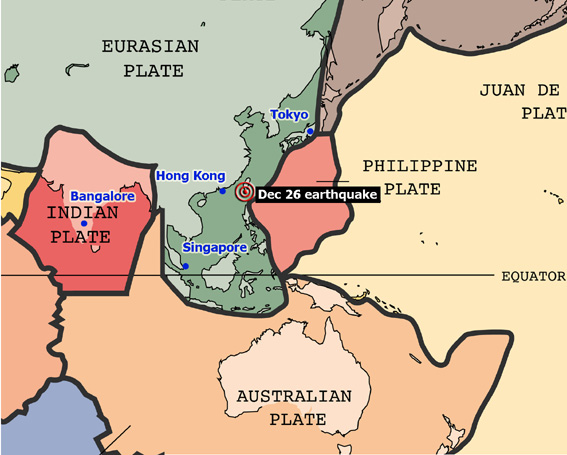Asia's cables on the blink

On Dec. 26, 2006, the Hengchun earthquake near Taiwan was actually two shocks within 5 minutes of each other at 8:30 p.m. Taiwan/Hong Kong/Singapore time (UTC 12:30 p.m.) The tremors, magnitudes 7.1 and 6.9, caused a 300-kilometer rupture in the sea floor that severed segments of several, important undersea cables:
The earthquakes occurred along the north-south boundary between the Eurasian and Philippine tectonic plates (green and pink, respectively, on the map below--click for larger view).

A Time magazine map shows the location of the quake, the routes (in blue) of the cables listed above, and the western boundary (in red) of the Philippine plate. Some cities in Asia are shown, too. The concentration of cables in the South China Sea is obvious.
The primary business impact of the cable breaks was to cripple data (and voice) traffic between north and south Asia--Singapore to Tokyo, for example, or Taipei to Hong Kong. Communication between Asia and North America was also heavily affected, because most trans-Pacific bandwidth terminates in North Asia, so the connection of a South Asia Internet user in Malaysia, for example, "hops" through Japan or Taiwan to a North American Web site. When the cables broke, that hop wasn't possible.
That's going to change eventually. Asia Netcom (the cable network least affected by the December 26 earthquake) has announced plans to build a new loop between the Philippines and the U.S. via Guam in the South Pacific, with a backup loop between Japan and North America in the North Pacific.
But undersea earthquakes will continue to occur in Asia, the world's most seismically active region, so multiple, simultaneous breaks of fiber optic communication cables laid on the seabed in the China Sea can be expected.
All of the undersea cable networks are owned and operated by investment consortia, because they are hugely expensive to build. Telcos in Asia have interests in multiple cable consortia, specifically for the purpose of mitigating dependency risk. As a result, many were able to provide limited service even after the December earthquake.
The BCP Blueprint The only alternative available to the cable consortia is to lay new cables on routes which avoid existing areas of concentration like the Luzon Strait. That's going to take some time. There's already a massive oversupply of underutilized, undersea bandwidth, so the financial incentive to string more cable is low at the moment.
Author's Note: The authoritative map of submarine cable routes is published by TeleGeography Research. You can view it online at this link. The poster version costs US$250. I hope Santa Claus brings me one next year.
Update February 20007 The South China Morning Post reported on 15 Feburary 2007 that "repairs on underwater internet and phone cables severely damaged late last year have been completed, 50 days after (the) earthquake." BCP Blueprint: if you're doing contingency planning for loss of voice and data lines in Asia, now you have historical occurrence of a nearly two-month period of impaired service.